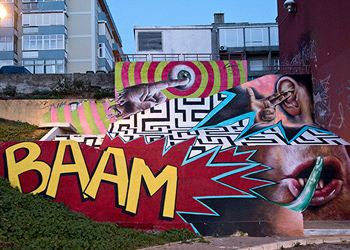Walls that talk

In 2001, hundreds of the slum houses that formed one of the largest and longest established shanty towns of Lisbon – Curraleira, between Paiva Couceiro Square and the suburb of Olaias – disappeared. Alongside this demolition, the residents were rehoused in new projects and new neighbourhoods dotted along the course of the Chelas Valley. Curraleira, now the site of a highway, was wiped off the map but remains very much alive in the memories of persons such as Mário Maia and João Alves, who grew up there. The pair guide us on a visit of the PA-REDES project, financed by the Calouste Gulbenkian Foundation PARTIS Program, one of the key means for the Foundation to support socially innovative projects.
The route of this visit includes various of the urban art murals produced within the scope of the project put into practice by the European Intercultural Club, the “Living Better in Beato” resident association and the AAAFBL – Association of Former Students of the Lisbon Faculty of Fine Arts, and interconnects strategic points that make up the community identity and memory of this territory.
At the high point of some open land, from where you may see the Alto de São João cemetery on the one hand and the social housing apartment buildings on the other, there stands a cross raised in memory of the death of a child in a large blaze that took place in Curraleira in 1975. This child again gets evoked in a mural located further away alongside a children’s playground. Here, around the site of the cross, no more shanty houses were built. This became a clearing where you could play football or use the cross as the base in games of hide and seek. João recalls such games well when they were still being played in Curraleira. Now, he is aged about 30 and takes a proactive role in the neighbourhood where he grew up through the Quinta do Lavrado residents association “Generation with a Future”, that he helps run. He sets about challenging these childhood memories, among many others, over the course of a walk of around two hours that provides the chance to discover a forgotten zone of Lisbon, very far from the tourism sites and the seemingly unstoppable gentrification of a city in fashion worldwide.
The PA-REDES project began in the neighbourhoods of João Nascimento da Costa and Carlos Botelho but naturally ended up expanding to those of Quinta do Lavrado and Bairro do Horizonte as these were the four neighbourhoods where the people were rehoused – and dispersed – following the demolition of the shanty homes they had been living in.
“I didn’t see, I didn’t hear and I don’t talk”
At the core of this urban art project and its building of a visitor route is the task of setting out the narrative of the neighbourhood: “It is not an easy route and whoever does it alone will not see anything. The interest comes in the stories that the people tell along the way”, said António Brito Guterres, of the Aga Khan Foundation, a project partner institution alongside Santa Casa da Misericórdia and GEBALIS.
The family of Mário, parents and grandparents, once lived in Praça do Chile, in central Lisbon. As they were members of the Romany community, they were “pushed out” to Curraleira. Today, Mário is clearly a landmark in the community; everybody greets him and residents listen to him and respect him. He tells us of the União Clube da Curraleira, where he used to spend time with his friends but that is now closed. Another of the stops takes in Chafariz do Alto do Pina, a neighbourhood renowned for its performances in Lisbon’s popular dance competitions. People would fetch their water from Chafariz (fountain) and hence it became a meeting point in a time when the supply of drinking water and sanitation was but a mirage in this part of the city. We correspondingly find water present in various murals – indeed, a central feature, with the buckets getting carried as well as the former wash tanks.
Each one of these large murals has its own “godfathers” and “godmothers”, residents designated by the community. Inspired by the methodology implemented by another urban art project in Bairro da Torre, in Cascais, residents got actively involved in producing the murals, establishing the connection with the local population, debated in assemblies that discussed neighbourhood memories while mobilising and putting the logistics into practice necessary to painting the walls. Among the artists that have already collaborated with the PA-REDES project are Francisco Camilo, Victor Feijó, Telmo Alcobia and the ARM collective (gonçaloMAR and Ram Miguel).
The route ends at one of the murals that now defines the landscape of Vale de Chelas. Its godfathers called the work “I didn’t see, I didn’t hear and I don’t talk”. Magda Alves, the project coordinator from the European Intercultural Club, explained: “This refers to the internal dynamics of the neighbourhoods but also reflects the ways in which these neighbourhoods are seen by people outside them, who do not know nor do they want to know what is going on there. They do not go into the neighbourhoods and base themselves only on stereotypes and prejudice. Therefore, this mural may have this dual reading.”
In Vale de Chelas, there are roads with abrupt dead ends, built to serve the bridge over the Tagus that never got off the drawing board; there is garbage and rubble dotted all over; there is a wastewater treatment plant and a high-tension power plant despite the protests of the local population. There are building with their entrances facing the cemetery wall, an aberration that arose out of administrative requirements. And there are many other undesirable things invisible in the light of day. However, there are also families, children, cheerful and bustling cafes and even small “farms” with well-cared for animals. There are also residents committed to improving their neighbourhoods and proud about making them better known.
